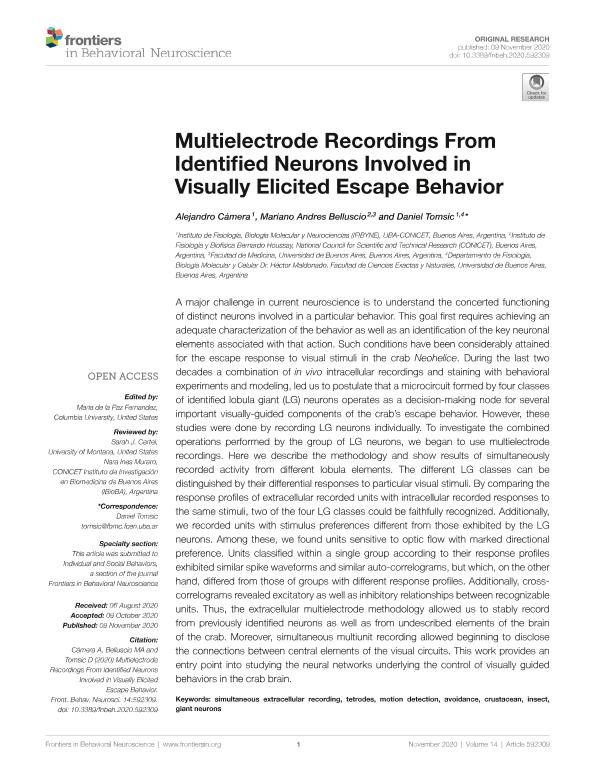Mostrar el registro sencillo del ítem
dc.contributor.author
Cámera, Alejandro Gabriel

dc.contributor.author
Belluscio, Mariano Andres

dc.contributor.author
Tomsic, Daniel

dc.date.available
2021-09-27T18:19:19Z
dc.date.issued
2020-11
dc.identifier.citation
Cámera, Alejandro Gabriel; Belluscio, Mariano Andres; Tomsic, Daniel; Multielectrode Recordings From Identified Neurons Involved in Visually Elicited Escape Behavior; Frontiers Media; Frontiers in Behavioral Neuroscience; 14; 11-2020; 1-15
dc.identifier.uri
http://hdl.handle.net/11336/141623
dc.description.abstract
A major challenge in current neuroscience is to understand the concerted functioning of distinct neurons involved in a particular behavior. This goal first requires achieving an adequate characterization of the behavior as well as an identification of the key neuronal elements associated with that action. Such conditions have been considerably attained for the escape response to visual stimuli in the crab Neohelice. During the last two decades a combination of in vivo intracellular recordings and staining with behavioral experiments and modeling, led us to postulate that a microcircuit formed by four classes of identified lobula giant (LG) neurons operates as a decision-making node for several important visually-guided components of the crab’s escape behavior. However, these studies were done by recording LG neurons individually. To investigate the combined operations performed by the group of LG neurons, we began to use multielectrode recordings. Here we describe the methodology and show results of simultaneously recorded activity from different lobula elements. The different LG classes can be distinguished by their differential responses to particular visual stimuli. By comparing the response profiles of extracellular recorded units with intracellular recorded responses to the same stimuli, two of the four LG classes could be faithfully recognized. Additionally, we recorded units with stimulus preferences different from those exhibited by the LG neurons. Among these, we found units sensitive to optic flow with marked directional preference. Units classified within a single group according to their response profiles exhibited similar spike waveforms and similar auto-correlograms, but which, on the other hand, differed from those of groups with different response profiles. Additionally, cross-correlograms revealed excitatory as well as inhibitory relationships between recognizable units. Thus, the extracellular multielectrode methodology allowed us to stably record from previously identified neurons as well as from undescribed elements of the brain of the crab. Moreover, simultaneous multiunit recording allowed beginning to disclose the connections between central elements of the visual circuits. This work provides an entry point into studying the neural networks underlying the control of visually guided behaviors in the crab brain.
dc.format
application/pdf
dc.language.iso
eng
dc.publisher
Frontiers Media

dc.rights
info:eu-repo/semantics/openAccess
dc.rights.uri
https://creativecommons.org/licenses/by/2.5/ar/
dc.subject
AVOIDANCE
dc.subject
CRUSTACEAN
dc.subject
GIANT NEURONS
dc.subject
INSECT
dc.subject
MOTION DETECTION
dc.subject
SIMULTANEOUS EXTRACELLULAR RECORDING
dc.subject
TETRODES
dc.subject.classification
Otros Tópicos Biológicos

dc.subject.classification
Ciencias Biológicas

dc.subject.classification
CIENCIAS NATURALES Y EXACTAS

dc.title
Multielectrode Recordings From Identified Neurons Involved in Visually Elicited Escape Behavior
dc.type
info:eu-repo/semantics/article
dc.type
info:ar-repo/semantics/artículo
dc.type
info:eu-repo/semantics/publishedVersion
dc.date.updated
2021-03-26T19:52:18Z
dc.identifier.eissn
1662-5153
dc.journal.volume
14
dc.journal.pagination
1-15
dc.journal.pais
Suiza

dc.description.fil
Fil: Cámera, Alejandro Gabriel. Consejo Nacional de Investigaciones Científicas y Técnicas. Oficina de Coordinación Administrativa Ciudad Universitaria. Instituto de Fisiología, Biología Molecular y Neurociencias. Universidad de Buenos Aires. Facultad de Ciencias Exactas y Naturales. Instituto de Fisiología, Biología Molecular y Neurociencias; Argentina
dc.description.fil
Fil: Belluscio, Mariano Andres. Universidad de Buenos Aires. Facultad de Medicina; Argentina. Consejo Nacional de Investigaciones Científicas y Técnicas; Argentina
dc.description.fil
Fil: Tomsic, Daniel. Consejo Nacional de Investigaciones Científicas y Técnicas. Oficina de Coordinación Administrativa Ciudad Universitaria. Instituto de Fisiología, Biología Molecular y Neurociencias. Universidad de Buenos Aires. Facultad de Ciencias Exactas y Naturales. Instituto de Fisiología, Biología Molecular y Neurociencias; Argentina
dc.journal.title
Frontiers in Behavioral Neuroscience
dc.relation.alternativeid
info:eu-repo/semantics/altIdentifier/url/https://www.frontiersin.org/articles/10.3389/fnbeh.2020.592309/full
dc.relation.alternativeid
info:eu-repo/semantics/altIdentifier/doi/http://dx.doi.org/10.3389/fnbeh.2020.592309
Archivos asociados
